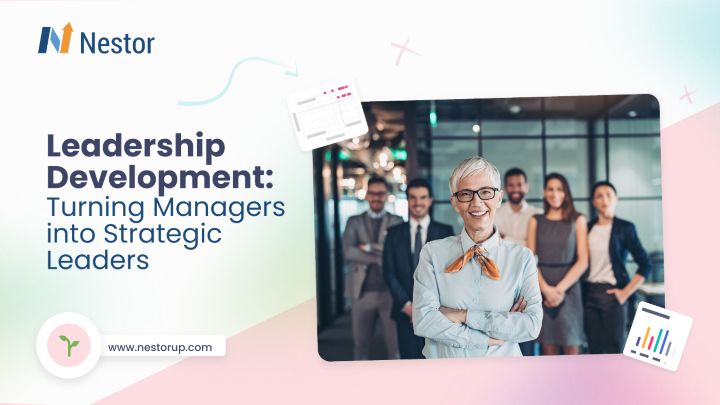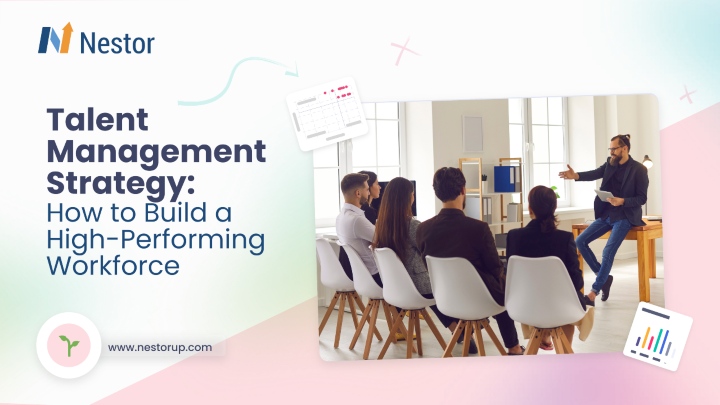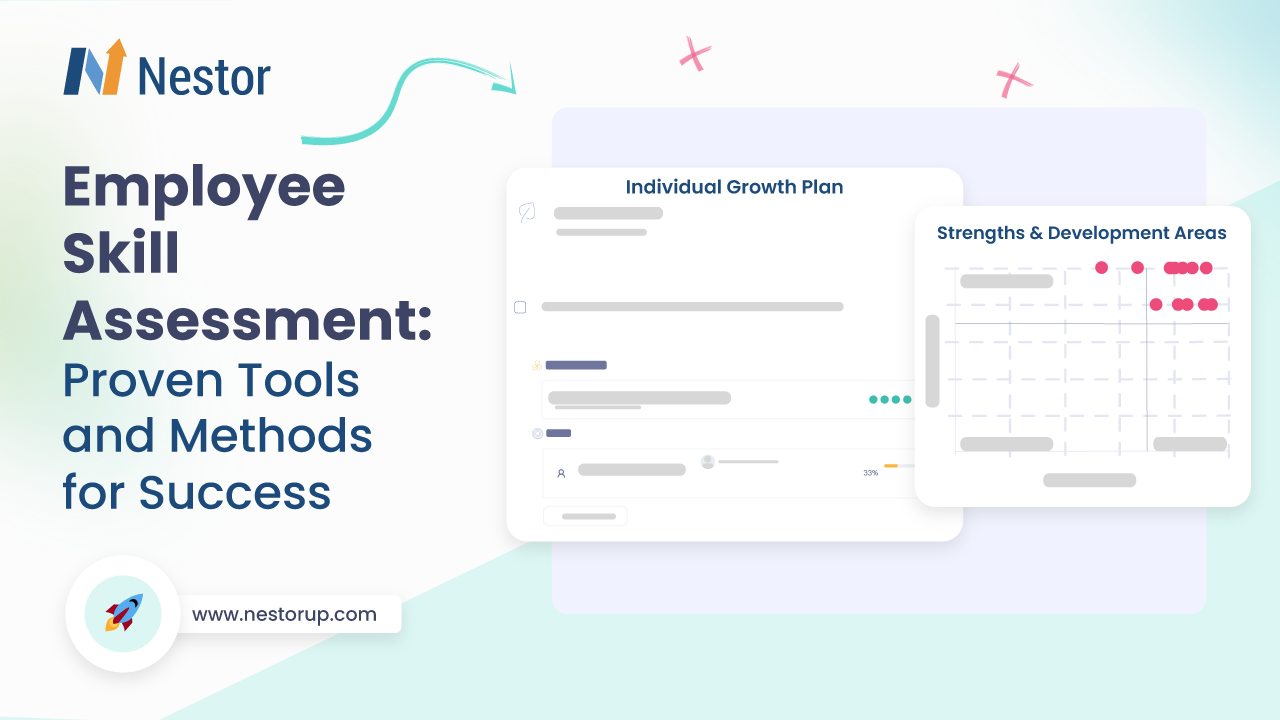
Contents
As HR and business leaders look for ways to enhance their talent management strategies, one critical factor stands out — the ongoing development of employee skills. And, as a direct consequence, employee skill assessment, or the ability to accurately determine the proficiency levels of your people has never been more important.
If the old saying “knowledge is power” is true, then knowledge about employee skills is quickly becoming the ultimate power, at least for modern organizations navigating today’s work landscape. High-performing organizations, in particular, rely on clear insights into their employees’ capabilities to maintain their edge. Yet, many still struggle with productivity challenges linked to skill gaps, disengagement, and inefficiencies.
What Does the Market Say?
According to McKinsey research, lost productivity among employees can often be traced back to three key factors: lacking the necessary skills (the skill gap), low engagement (the will gap), and inefficient use of time (the time gap). These issues are costing companies millions annually, and they highlight the critical need for effective skill assessment and development initiatives. When these gaps are left unchecked, they lead to broader talent challenges, such as high attrition and vacancy rates, which can significantly impact organizational performance. These issues could cost a median-size S&P 500 company around $480 million annually in lost productivity alone, underscoring the critical need for targeted skill assessment and development.
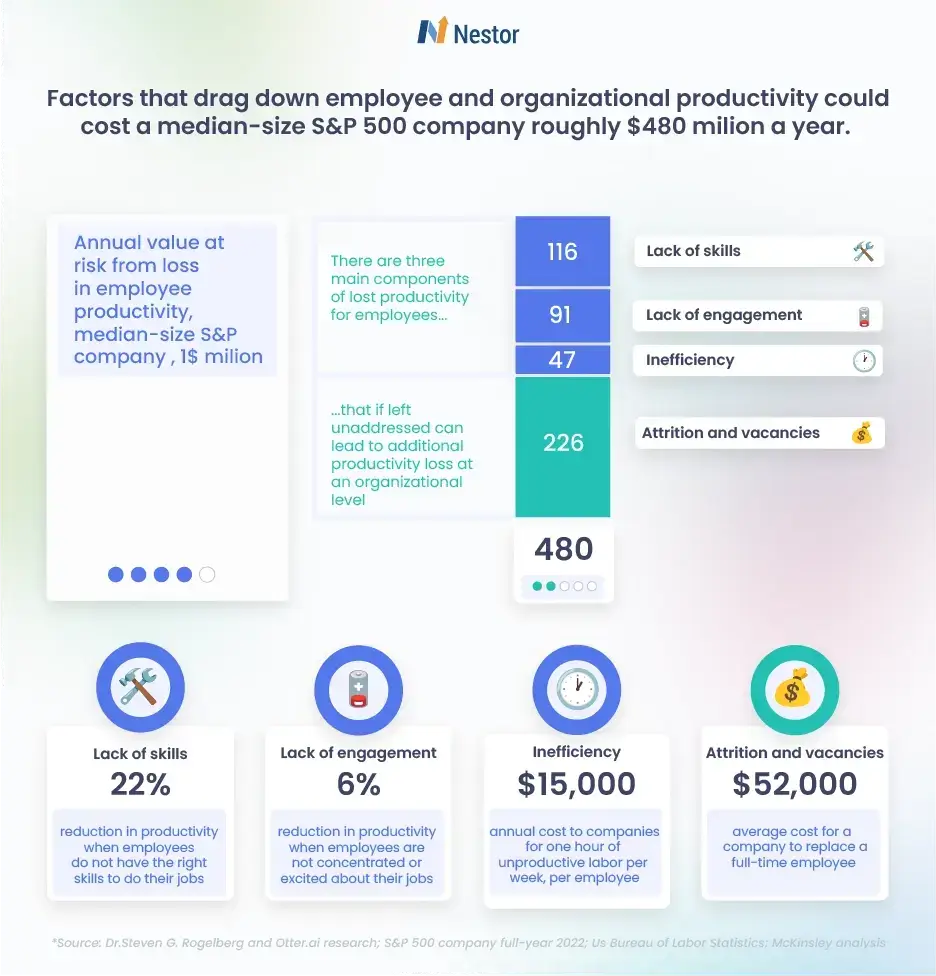
Additionally, skills-based hiring is rapidly gaining momentum. The State of Skills-Based Hiring 2024 Report, reveals that 81% of employers now incorporate some form of skills-based hiring, up from 73% in 2023 and 56% in 2022. Moreover, 95% of employers agree that skills-based hiring will dominate future recruitment strategies. This surge highlights just how essential it is to have a clear and accurate understanding of your employees’ capabilities.
Let’s explore the world of employee skill assessment together. We’ll look at why it’s so important, the benefits it provides, and the most effective methods and tools you can use to get the best results. Whether you’re refining your current approach or starting fresh, this guide will offer valuable insights to help you manage and develop your workforce effectively.
What Is Employee Skill Assessment?
Employee skill assessment is a process that involves one or multiple evaluation methods with the aim of identifying the strengths and weaknesses of an individual’s skill set. The main goal is to determine their suitability for a current or future job role, the process being often used in:
- Hiring: To ensure candidates possess the skills required for the job.
- Personalized L&D initiatives: To tailor training programs to individual needs.
- Promotion decisions: To assess readiness for higher responsibilities.
- Succession planning: To identify potential leaders and prepare them for future roles.
- Team building and project assignments: To match skills with project requirements and team dynamics.
To deliver the expected results, employee skill assessments should be holistic in nature, and look at all the skills types relevant to a given position or project, which means the process can be broken down into:
- Soft or power skills assessment
- Technical or hard skills assessment
- Job-specific skills assessment
The relevancy and accuracy of results are largely determined by how regularly this process takes place and by the type (or combination) of evaluation tools.
Best Practices for Effective Employee Skill Assessment
To achieve meaningful results, consider these best practices:
- Regular Assessments: Frequent evaluations help track progress and adapt to changing needs. Regular assessments ensure that skill development is ongoing and relevant.
- Diverse Evaluation Tools: Using a mix of assessment methods provides a well-rounded view of an employee’s capabilities. This can include tests, simulations, interviews, and self-assessments.
- Clear Criteria: Define what skills are necessary for each role and create clear criteria for assessment. This clarity helps in making informed decisions and setting realistic expectations.
The key to getting useful results? Regular assessments and using the right mix of evaluation tools.
What Are the Benefits of Employee Skill Assessment?
You might be thinking, “I know my team. Why do I need formal assessments?” Well, you’re not alone in that thought. According to a report from Mercer, 2 in 5 HR leaders acknowledge they don’t know what skills they have in their workforce. This is especially worrying in a business environment where skills and skills-based approaches are supporting organizations to make more informed talent decisions aligned with business priorities.
However, identifying employee skills and subsequently collecting and organizing them in a skills library is not enough. This is where the role of skills verification or validation comes in — something we’ll explore more in the next section.

In addition to revealing the proficiency level of your workforce, employee skill assessments also help:
Identify and retain the most skilled workers
Let’s talk about why assessing your employees’ skills is so valuable. Skill assessments help you find those standout team members who are not only great at what they do but are also key to your business. These are the people who have the skills you need now and in the future.
Skill assessments, therefore, will help you identify the critical people within your organization who are highly skilled for essential roles and, consequently, difficult to replace. By focusing on employees who already have or are developing in-demand, trending, or emerging skills, you can ensure that your team remains agile and well-equipped to meet industry challenges.
This is especially important in the current work landscape, where the labor market is tight, and talent shortages significantly impact business performance and development.
These statements are also backed up by numbers. Companies that have a solid learning culture see their employee retention rates increase to 57%. In comparison, those with just a moderate focus on learning see a much lower retention rate of 27%. This highlights the significant impact that a strong commitment to employee development can have on keeping your top talent.
Support succession planning decisions and compare candidates
Skill assessment tools are also the first step in the process of identifying suitable candidates for (top) leadership positions and other business-critical roles.
The results of these assessments will help narrow down talent pools and compare different people, eventually leading to the creation of a leadership pipeline — ensuring that business continuity and knowledge loss won’t be an issue and a certain number of people are ready to step up when needed.
Learn more about identifying potential leaders and the succession planning process.
Select the best learning and development initiatives for employee skill assessment
Through strategic employee skill assessment, you will identify the most pressing development needs. Consequently, you can select personalized or tailored programs that yield the best results.
By focusing only on the most effective and impactful L&D initiatives, your company will save both time and money and address real pain points or areas for improvement for every employee.
This shouldn’t be limited to formal learning opportunities, like training programs or courses. Instead, the focus should also be on selecting the best informal opportunities, including temporary projects, job shadowing, coaching, and mentorship — all facilitated by a talent marketplace.
Also, keep in mind that 20% of Gen Z employees feel their managers don’t fully understand their skill development needs according to the Talent LMS Report. By using skill assessments to guide your development choices, you can better align your initiatives with your employees’ actual needs and aspirations.
Overcome personal biases in decision-making with employee skill assessment
Biases or subjective judgments can emerge during hiring, promotion talks, or career development plans. This doesn’t only affect HR or people managers.
Sometimes, employees themselves may not be fully aware of what they need, how to best use their skills, or what career paths they might pursue going forward. Thanks to the employee skill assessment process, it becomes clear what areas would benefit most from additional learning and lead to significant professional growth.
Ensure a higher level of performance with employee skill assessment
Since business needs are constantly evolving and shifting, it is critical to ensure that your employees have the right skills, capabilities, and the necessary expertise to execute business strategy and meet performance expectations.
And the best way to check if people within the company have up-to-date skills and meet the (minimum and desirable) requirements for their roles is through regular skills evaluations.
By checking in on how well your team’s abilities match the requirements of their roles, you can ensure they’re not just meeting expectations but also prepared for future challenges. Gallup found that employees who receive weekly feedback are 5.2 times more likely to strongly agree that they’re getting meaningful feedback. This kind of regular check-in can make a real difference in how employees feel about their development and their role in the company. Furthermore, it can enhance their engagement and satisfaction, contributing to overall organizational success.
Steps for the Employee Skill Assessment Process
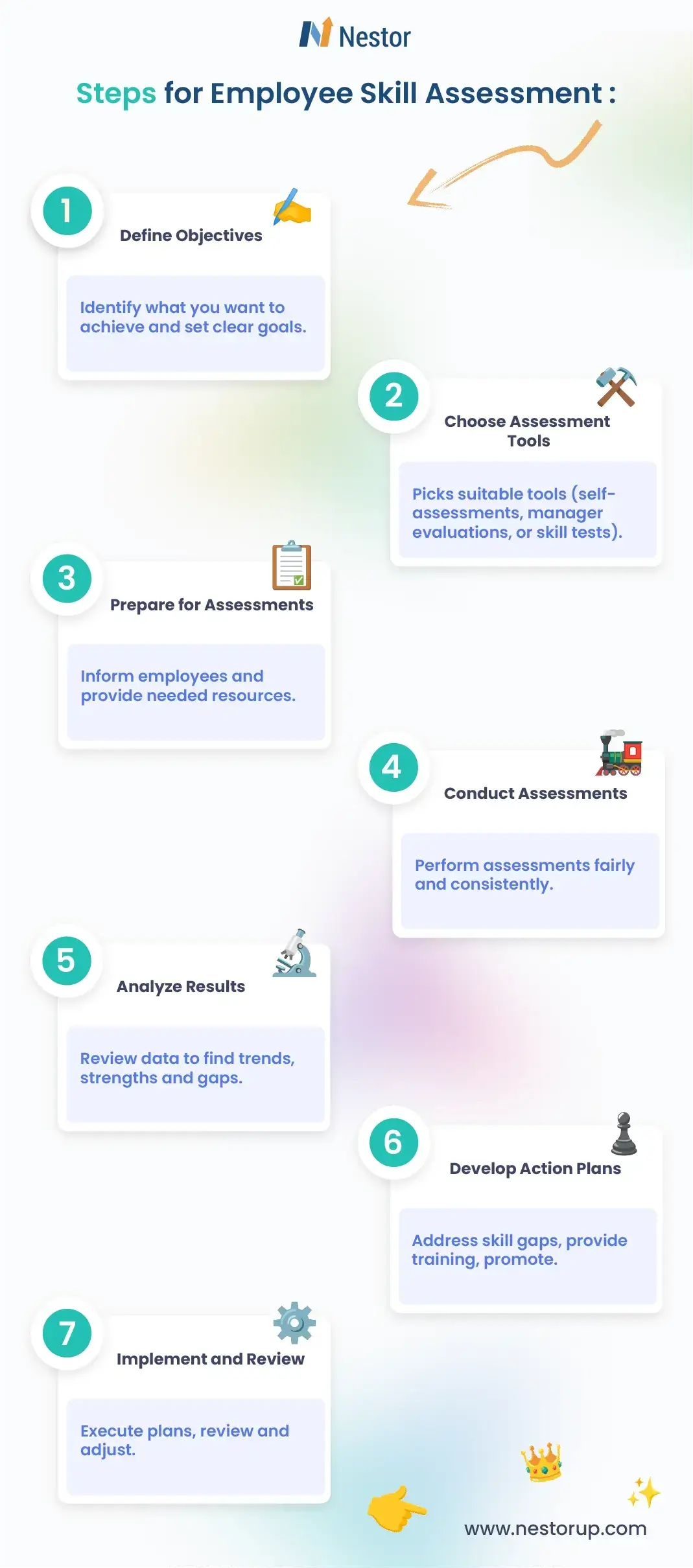
Our employees are the heart of our organization. Their skills, talents, and expertise drive our success. That’s why a well-structured skills assessment process is so important. So, let’s walk through this process together, shall we?
Define objectives
First things first – we need to know where we’re heading that’s why you need to establish clear goals for the skills assessment initiative. Are you looking to improve the overall performance of your team? Or maybe you want to help your staff explore career paths within the company. Whatever your goals, defining them upfront will keep you on track throughout the entire process.
Choose assessment tools
Now that you know what you’re aiming for, it’s time to pick your tools. Options include:
- Self-assessments
- Manager evaluations
- Peer reviews
- Skill-specific tests
Each method offers unique benefits, so consider combining approaches to gain a comprehensive view of your team’s capabilities. Choose tools that complement your company culture and assessment objectives.
Prepare for assessments
Communication is crucial at this stage. You need to make sure everyone understands what’s happening, why it’s important, and how they can prepare. This might involve providing some training on how to give constructive feedback, or offering resources to help employees reflect on their skills. The more prepared everyone feels, the smoother your assessment journey will be.
Conduct assessments
Execute the assessments according to your plan. In addition, maintain consistency in your approach to ensure fair and reliable results across all participants. Furthermore, create a supportive environment that encourages honest feedback and self-reflection.
Analyze results
You need to look for patterns, trends, and insights that can help you understand the team better. Where are your team collective strengths? What areas could use some extra attention? Are there any surprising skills that you didn’t know your team had? You should look for:
- Skill gaps within teams or departments
- Areas of exceptional performance
- Trends that may impact future workforce planning
Develop action plans
Based on your findings, create targeted action plans to address identified needs and capitalize on strengths. These plans might include:
- Customized training programs
- Mentoring initiatives
- Cross-functional project assignments
- Career progression opportunities
Ensure that your action plans are specific, measurable, and aligned with both individual employee goals and broader organizational objectives.
Implement and review
Put your action plans into motion, but remember, this isn’t a “set it and forget it” situation. You need to stay flexible and open to feedback. Regular check-ins can help you gauge how your action plans are working in practice.
Are you seeing the improvements you hoped for? Are there unexpected challenges you need to address? By staying attuned to your team’s experiences and outcomes, you can fine-tune the approach and ensure that things are always moving in the right direction.
Free Employee Skill Assessment Template
We’ve also put together an employee skill assessment free template that’s designed to take the headache out of the whole process. It’s free, and trust me, it’s going to make your life a whole lot easier.
So, what’s included in this? Well, we’ve packed everything you need:
- A straightforward employee skills assessment for managers to use
- A self-assessment tool for employees
- A 360-degree feedback form to get the full picture
- Some handy examples to show you how it all works
The best part? You don’t need to be an HR expert to use it. We’ve made it super user-friendly and flexible enough to work for all sorts of teams and companies.
Why should you give it a shot? Well, it’ll save you time, keep things consistent, and help you really understand what your team can do. Plus, it opens up great conversations about growth and development.
Get the FREE employee skills assessment template now.
Choosing the Right Employee Skill Assessment Tool: Traditional vs. Modern
When assessing employee skills, businesses face a choice between traditional methods and modern tools. Both approaches have their pros and cons, but understanding these can help you make the best decision for your organization.
Traditional Assessment Tools for Employee Skill Assessment
Let’s start with the classic approach to skill assessment—traditional tools. These include paper tests, manual surveys, and in-person interviews. They’ve been around for decades and, in many ways, have set the standard for how we evaluate employee skills.
Paper tests and manual surveys:
Paper-based tests and manual surveys are straightforward. Employees fill out forms, which are then scored manually. However, this process is prone to human error and can be slow. With limited data analysis capabilities, it’s hard to gain deeper insights into skills or track trends.
For larger teams, the process can become cumbersome and time-consuming. And though it might appear cost-effective initially, the long-term expenses—considering both time and manual handling—can add up.
According to Gallup, a traditional performance review can cost between $2.4 million and $35 million per 10,000 employees. This figure includes not only the direct costs of conducting reviews but also the significant HR hours needed to manage and process the results.
In-person interviews:
In-person interviews allow for a deeper understanding of a candidate’s skills and personality. However, they can be subjective, influenced by the interviewer’s biases, and require significant time to schedule and conduct. For businesses with a large number of candidates, this method can quickly become impractical and overwhelming.
Modern Assessment Tools for Employee Skill Assessment
As technology has advanced, so do the ways we assess employee skills. Nowadays, we have a variety of modern tools at our disposal, including AI-based assessments, online platforms, and digital simulations. These tools make the process more efficient, accurate, and scalable.
AI-based assessments:
AI-based assessments use algorithms to score responses automatically, reducing human error and providing quick, accurate results. They handle large volumes of data efficiently, making them suitable for growing companies. AI assessments offer immediate feedback and can be highly customizable, adapting to responses for a more tailored evaluation.
Online platforms and digital simulations:
These tools provide interactive, engaging assessments with real-time feedback. They scale easily, making them ideal for large or expanding organizations. Although the initial setup cost may be higher, automation can reduce long-term expenses. Digital simulations, in particular, are useful for evaluating skills in practical, real-world scenarios, giving a clearer picture of how employees might perform on the job.
Comparing Traditional and Modern Tools on Employee Skill Assessment
Here’s a quick comparison:
- Scalability: Traditional tools are limited; modern tools handle large data volumes efficiently.
- Data Accuracy: Traditional methods risk human error; modern tools offer high accuracy with automated scoring.
- Feedback Speed: Traditional tools provide slow feedback; modern tools offer instant results.
- Customization: Traditional tools have fixed questions; modern tools are highly customizable.
- Cost: Traditional methods may be cheaper initially but cost more long-term; modern tools have higher initial costs but can be more cost-effective over time.
- Data Security: Traditional methods risk data loss; modern tools have advanced security features.
- User Experience: Traditional tools can be cumbersome; modern tools are user-friendly and interactive.
- Technical Requirements: Traditional tools need minimal tech; modern tools require digital platforms.
- Analytics: Traditional methods offer basic reporting; modern tools provide advanced analytics.
- Bias and Errors: Traditional tools are more prone to bias; modern tools use standardized algorithms to reduce bias.
Making the choice
The decision between traditional and modern tools depends on your organization’s needs. Traditional methods are familiar and straightforward but can be limited and slow. Modern tools offer efficiency, accuracy, and scalability but come with higher initial costs and require digital infrastructure.
Consider your organization’s size, the skills you need to assess, and your long-term goals. The right tool can enhance how you manage and develop talent, shaping your organization’s future success.
So, which will you choose? Will you stick with the familiar or embrace the innovative? The answer could define how effectively you assess and develop your team.
Nestor’s employee skill assessment tools
Let’s take a closer look at the solutions included in our platform, which enable you and your employees to enjoy a more seamless skill assessment process. Keep in mind that these are mainly targeted at your current workforce, not job candidates.
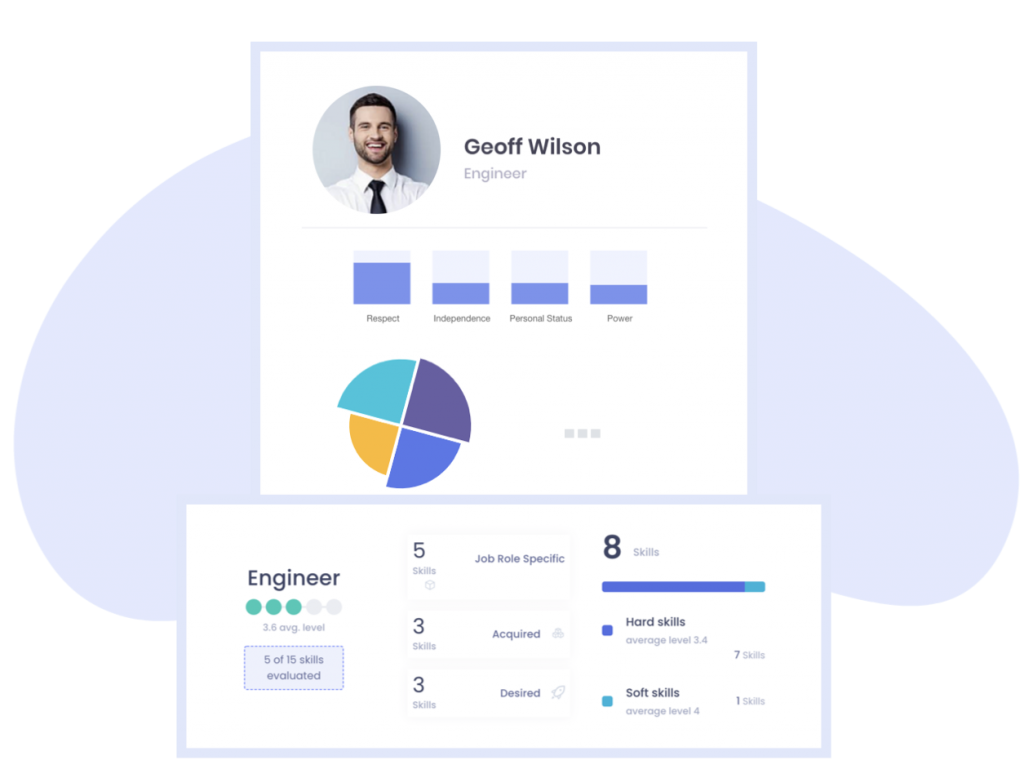
Self-assessment
Self-assessment is perhaps one of the most (if not the most) common ways employers use to evaluate the skills of their people. One of the key benefits is that its introspective nature encourages personal responsibility, helping employees become more objective in their assessments (in time) and learn how to classify and describe their capabilities more accurately.
The downside, however, is that this type of skill assessment can be quite biased, in both directions: people can either overestimate or underestimate their own abilities. Which leads us to an important point:
The most important aspect of employee skill assessments is knowing the actual skill level of people. This means self-evaluations are only useful when validated by other sources, like manager input or peer feedback.
If companies only (or mostly) rely on self-assessments, they run the risk of ending up with inaccurate data on skills and gaps, leading to ineffective L&D strategies and resources invested in development programs that fail to address critical pain points.
On the Nestor platform, employees can self-evaluate their skills very easily, using a 1-5 ranking system. However, these evaluations will only be displayed on their profiles after direct managers validate the proficiency level for that particular skill.
In addition to the typical hard, soft, and job-specific skills, we also offer the option to add and (self) evaluate abilities from previous experiences, which we refer to as acquired skills. These may or may not be relevant or necessary for a person’s current role within your company, and each employee can self-assess these skills without requiring the validation or approval of their manager. They will simply show up on the employee’s skill profile.
Manager assessment
This type of assessment has one main goal: to confirm (or not) the initial self-assessment of an employee — which, as we’ve seen, can be biased — for a particular skill or multiple skills.
Unlike the performance review or evaluation (which we’ll explore shortly), the (skill) assessment from managers or supervisors does not include a discussion or further plans for development. It’s just a quick confirmation that a certain proficiency level has been reached (or not).
Peer endorsements
Peer endorsements are similar to assessments from managers or supervisors — they confirm, or at least provide further evidence that a particular employee has certain skills, and expertise, and has (significantly) contributed to their team goals.
People who aren’t from the same team or department, or simply don’t have insights into someone’s actual hard and job-specific competencies, can still provide feedback on soft skills, based on their experience of collaborating and communicating with a given colleague during cross-departmental projects.
Performance management reviews
Since we fully embrace the power of skills, which are at the heart of all our talent solutions, it’s only natural that performance management is also focused on skill development on our platform.
By adopting this skill-centric approach to performance reviews, we make it easier to highlight the current status and level of a worker’s skill set as well as their actual potential for improvement. With this model, you actually look at how well the employee performs or uses/develops the skills necessary to meet their (performance) goals.
Similarly to self-assessment, individuals first evaluate themselves, using the same 1-5 skill grading system. Then, the manager uses the same evaluation criteria and system to assess employees from their perspective.
The results are then compared, or overlapped if you like, using easy-to-understand visual representations, such as interactive dashboards, through which you can quickly notice the differences in perspectives and skill evaluations.
Unlike simple supervisor assessments, the insights that emerge during performance reviews act as the basis for future discussions and feedback between the manager and the employee, and the establishment of updated personal development plans — which are mutually agreed.
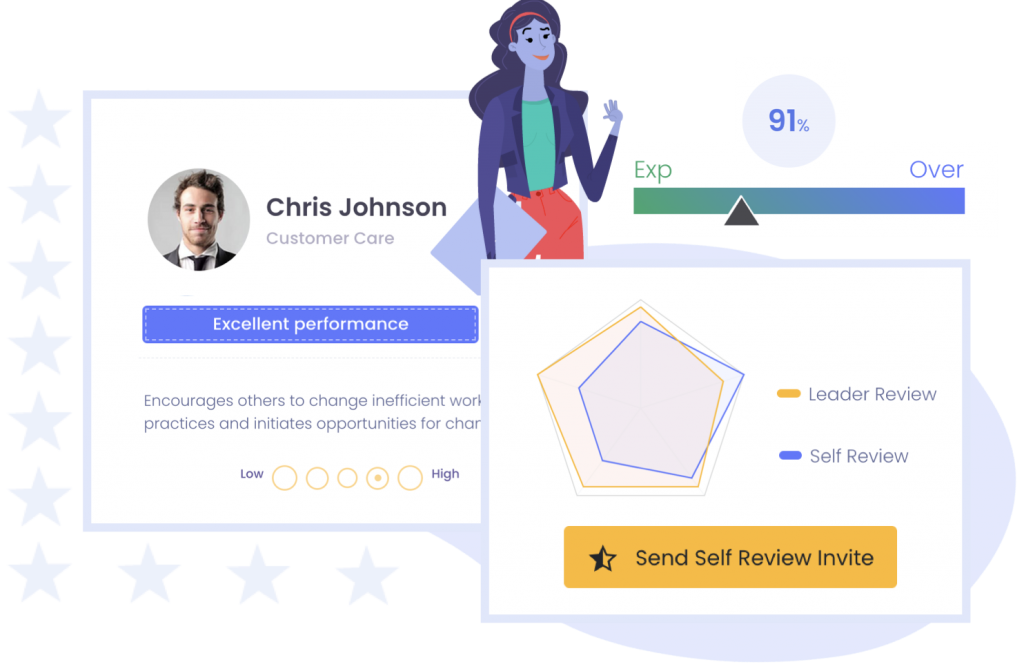
360 feedback
Taking advantage of input from multiple sources is another way of strengthening the accuracy and relevancy of your employee skill assessment process.
And this is what 360 feedback is all about on our platform. It provides a more complete and accurate image of an employee’s behaviors, attitudes, EQ, strengths, and weaknesses based on manager, peer feedback, and direct reports feedback.
Depending on the organization and its specific policies, 360 feedback can also play a critical role in promotions to leadership positions as it provides a more holistic view of a person’s full potential, still strongly connected with behaviors and competencies but including qualitative data also.
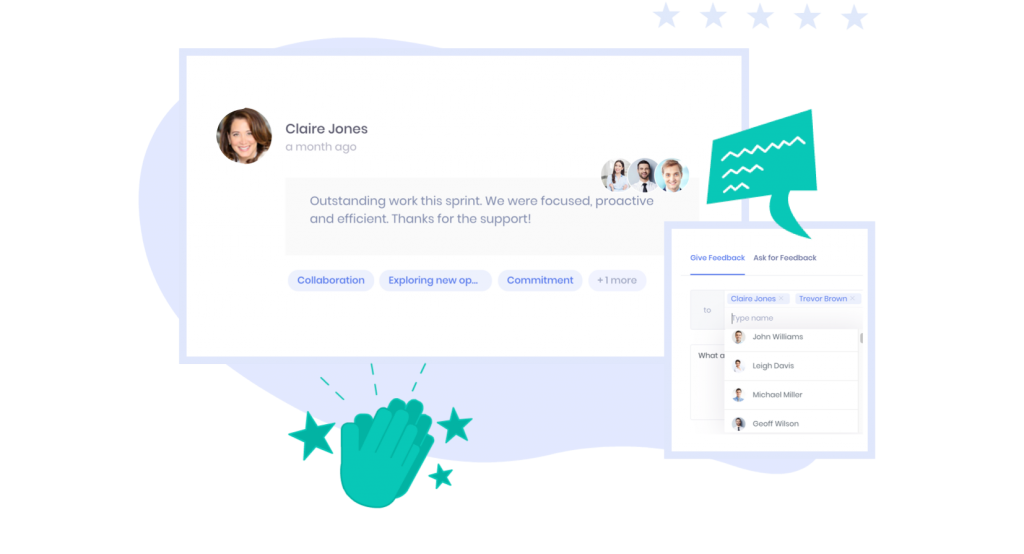
Other employee skill assessment tools and practices
Besides the evaluation methods presented above, it’s worth highlighting that there are also some more specific tests and examinations, mainly designed to evaluate the job fit of potential hires or to ensure compliance and risk management for employees with very specific skill types. So let’s explore together some popular skill assessment tools available in the market that can help you achieve your goals.
Skill tests and knowledge examinations
These evaluation tools work best for hard or job-specific skills, or, in other words, skills that are easy to quantify and measure.
They are most relevant for highly specialized fields, like power plant management or civil engineering, for example — with both public and private institutions using them for either job applicants or promotion decisions.
However, it’s not uncommon for companies in other industries (e.g., IT, telecommunication) to use either internal skill tests or external ones (provided online by various institutions) to quickly and objectively assess how well an employee can use a specific tool, software, machinery, etc.
Modern skill examinations can go beyond the traditional test format. For instance, by using cutting-edge technology such as AI, these assessments can deliver accurate benchmarks for large numbers of people in a short time.
Compliance tests
Compliance tests are most useful in specific industries, such as finance, insurance, construction, and engineering, among others. These types of tests, therefore, help to evaluate whether employees have the right understanding and ability to follow specific laws, regulations, and policies.
They are common in high-risk industries. Both senior employees and site managers are responsible for others’ safety and adhering to best practices and standards.
The topics or themes of compliance tests can vary from one industry to another; however, they usually cover areas such as workplace safety, financial regulation, data protection, or ethical conduct.
Job simulations
Job or work simulations are an excellent opportunity to see how a potential employee uses their skills to respond in the face of unfamiliar or difficult situations.
Simulations involve practical exercises. They offer quick, clear insights into more than just skills. They show how a person’s mentality and attitude affect their results and those of their team. This reveals if they are a good cultural fit.
Behavioral tests and interviews
Behavioral tests are somewhat similar to work simulations, in that they also look at personality or character trains (in addition to skills) in relation to a specific situation or task.
For job candidates, this often means presenting a situation in which they use a combination of skills and personal qualities to overcome a challenge or rapidly adapt to unforeseen events.
You can also make use of gamification approaches so that the evaluation process is more seamless and can happen through more interactive fun activities and casual interactions.
Frequently asked questions (FAQ) about employee skill assessment
How do you assess employee skills?
There are various ways to assess employee skills. For instance, some of the most common methods we’ve presented include self-assessment, performance reviews, 360 feedback, skill tests, job simulations, and behavioral examinations. By strategically selecting and combining these tools, you will often achieve the best and most accurate results.
What is a work skills assessment?
A work skills assessment is either the entire process or just one instance of it. During this process, a specific method or set of tools is used to determine an employee’s current skill levels.
How do you prepare for a skills assessment?
To prepare for a skills assessment, organizations and HR departments should first define their objectives and the skills they want to evaluate. Next, they need to choose evaluation methods and establish metrics to measure the process’s success.
Final thoughts
Employee skill assessment shouldn’t be regarded just as a task, but rather as a strategic investment in the future success of your organization.
By embracing a comprehensive approach and consistently evaluating and nurturing the skills of your people, you can create a culture of continuous improvement and adaptability, thus laying the foundation for a resilient and agile workforce.
With Nestor’s People Intelligence Platform, you can simplify, speed up, and improve the accuracy of employee skill assessment. That’s because skills are at the center of every solution we provide; consequently, decisions regarding L&D, promotions, and performance are based on real-time data.
Schedule a free demo to learn how we can enable your organization to accurately assess and develop the skills of your talented workforce.






